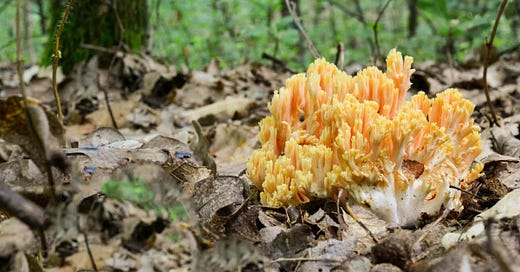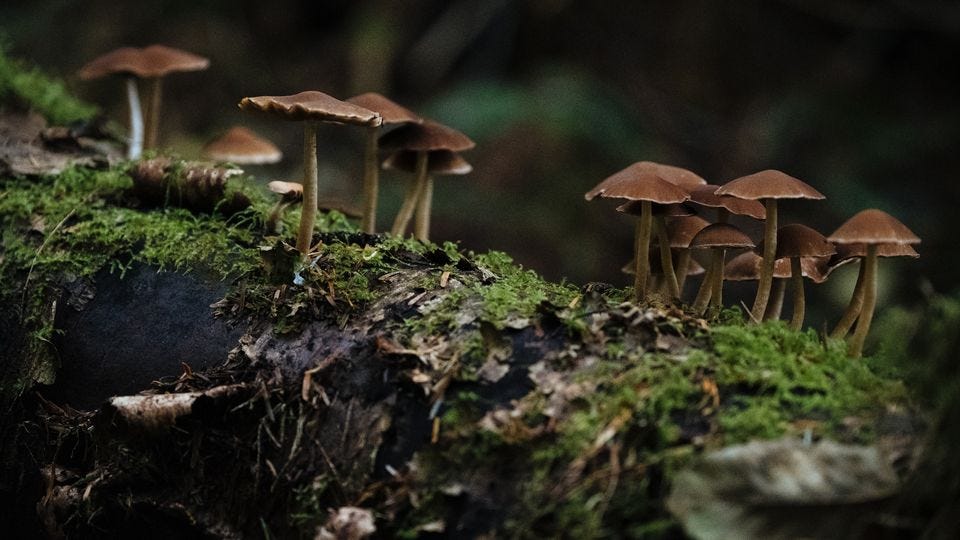Fungi fam,
Welcome back to this weeks edition of your favorite fungi publication on the internet, Fungi Friday! I have some exciting news (finally) — but I won’t spoil it yet. Scroll down a bit and you’ll figure it out (it’s Iowa Fungi related!) This week we have a sustainability theme to the article. The more I learn, the more I tend to believe fungi are going to play a massive role in humanities path towards a cleaner, more sustainable livelihood here on this beautiful planet.
In today’s email:
Fungi fueled fossil fuel absorption… say that five times fast!
Fungi slashed emissions in the construction industry
Fungi can sweat? Fascinating.
Iowa Fungi’s Update of the Week
It’s DONE! The trailer is moved. Time to get to work — well, almost. I’m traveling this week, so upon my return home next week, it’s go time. If all goes to plan, by next week’s article i’ll have a few images of the new setup for you all. Patience my friends, it’s coming!
Underground fungi absorb up to a third of our fossil fuel emissions
Did you know that fungi could be the key to fighting climate change? A new study published in the journal New Scientist found that underground fungi could be absorbing up to a third of our fossil fuel emissions.
The study, led by Heidi-Jayne Hawkins at the University of Cape Town, South Africa, found that fungi in the soil are able to store carbon by breaking down organic matter and releasing it into the atmosphere as carbon dioxide. This process is known as "carbon sequestration."
The researchers estimate that fungi could be storing up to 200 billion tons of carbon per year, which is equivalent to the emissions from 40 billion cars. This makes fungi one of the most important carbon sinks on the planet.
The study's findings suggest that we need to start thinking about fungi as a way to mitigate climate change. By protecting and restoring forests and other ecosystems where fungi thrive, we can help to increase the amount of carbon that is being stored in the soil.
In addition to storing carbon, fungi also have a number of other benefits for the environment. They can help to improve soil quality, reduce erosion, and break down pollutants. As we continue to learn more about the amazing abilities of fungi, we can find even more ways to use them to help us build a more sustainable future.
Psychedelic Spotlight
First-Of-Its-Kind Study Reveals How Psilocybin Therapy Helps Treat Alcohol Addiction
Bend your mind around this: the great medicinal psychedelic revival has begun
Revolutionizing Mental Health: The Rise of Psilocybin Therapy in New York
‘A real material for the future’: Could homes made of fungi slash emissions from construction?
The construction industry is a major contributor to climate change. The production of cement, a key ingredient in concrete, is responsible for about 8% of global carbon emissions.
But there's a new material that could revolutionize the construction industry and help to reduce emissions: mycelium. Mycelium is the root system of fungi, and it has a number of properties that make it ideal for construction. It's strong, lightweight, and fire-resistant. It's also biodegradable and sustainable.
A company called MycoWorks is developing mycelium-based building materials. The company has already created mycelium-based bricks, panels, and insulation. These materials can be used to build everything from homes to furniture.
MycoWorks' products are still in the early stages of development, but they have the potential to revolutionize the construction industry. If mycelium-based materials become widespread, they could help to reduce emissions from construction and create a more sustainable future.
Here are some of the benefits of using mycelium in construction:
Reduced emissions: Mycelium-based materials are made from renewable resources, so they don't contribute to climate change.
Sustainability: Mycelium is a natural material that can be composted at the end of its life, so it doesn't create waste.
Strength: Mycelium-based materials are strong and durable, so they can be used to build a variety of structures.
Fire resistance: Mycelium-based materials are fire-resistant, so they can help to keep people safe in the event of a fire.
As the construction industry continues to look for ways to reduce its environmental impact, mycelium-based materials could be a promising new option.
More Mushroom Mentions
‘Fungi reflect Earth’s incredible history — they power plant life but face human impacts now’
“It’s time to interrupt the North American mushroom industry”
Fungi seem to 'sweat' to stay cool and scientists don't know why
Fungi are often thought of as cold-blooded creatures, but a new study has found that they can actually "sweat" to stay cool.
The study, published in the journal Nature, found that fungi release water vapor through their surfaces, a process known as evapotranspiration. This process helps to cool the fungi down and prevents them from overheating.
The researchers found that fungi are more likely to sweat when they are exposed to high temperatures or when they are under stress. They also found that fungi that live in hot environments, such as deserts, are more likely to sweat than fungi that live in cooler environments.
The study's findings suggest that fungi may be more adaptable to hot environments than previously thought. They also suggest that fungi may play a role in regulating the Earth's climate.
Here are some of the implications of this finding:
Fungi may be more adaptable to hot environments than previously thought. This could lead to the discovery of new fungal species in hot environments, such as deserts.
Fungi may play a role in regulating the Earth's climate. By sweating, fungi can help to cool the Earth's surface and prevent it from overheating.
Fungi may be used to develop new ways to cool down buildings and other structures. By mimicking the way that fungi sweat, we could develop new materials that can help to keep us cool in hot environments.
As we continue to learn more about fungi, we may discover even more amazing things about these fascinating organisms.
That’s all, folks… but before we let you go, leave a comment below on how we can make the publication even better! And if you haven’t yet, smash that SUBSCRIBE button below.
Thanks for reading as always,
BowTiedMushroom




